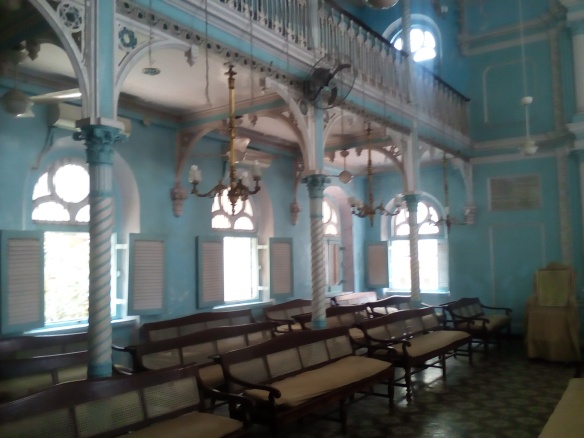A little down the road from my field site there is a cemetery with an entrance plaque that reads: “Set apart for ever by Elias David Sassoon Esq in January 1878 as a Jewish burial ground in memory of his beloved son Joseph, who died at Shanghai in China”.

Plaque outside Jewish Cemetary on Delisle Road (N M Joshi Marg)
So who was Elias David Sassoon, and what was his son doing in Shanghai? Both questions cut deep into the heart of Bombay history in a surprising way.
The Sassoons were a family of Middle Eastern Jewish bankers, often called the “Rothschilds of the East”, who initially rose to prominence in Baghdad. Following a change in political climate, patriarch David Sassoon fled to Bombay in the 1830s and rapidly established a business empire, based partly on the textile trade. He lived in a handsome residence in Byculla, now reincarnated as the Masina Hospital (named after Parsi philanthropist Jerbai Masina), and the family have left a visible legacy across Bombay’s built environment.

Masina Hospital, formerly the private residence of David Sassoon
This includes two beautiful synagogues: the Magen David synagogue in Byculla, built by David Sassoon himself, and the Knesset Eliyahoo synagogue in Kala Ghoda built by his grandson Sir Jacob Elias Sassoon. They are a testament to the growing “Baghdadi” Jewish community in 19th Century Mumbai, drawn from Middle Eastern centres of Jewry such as Baghdad, Basra and Aleppo. Both are still operational today, although the Baghdadi community has dwindled to microscopic levels following emigration to Israel and the West.
Better known is the David Sassoon Library, initially a Mechanics’ Institute which was funded by David Sassoon and completed in 1870. Still functioning as a popular library, its garden provides a magical setting for panel discussions during the Kala Ghoda Arts Festival in February. Further south, off Cuffe Parade, are the Sassoon Docks, established by David’s son Albert Sassoon. Although now a fish market, it was initially Bombay’s first “wet” dock, which facilitated the loading of cotton, thus playing a vital part in the cotton trade which dominated Bombay’s economy from the late 19th century until the mill strikes of 1982-3. Indeed, the Sassoons were heavily involved in Bombay’s cotton industry, opening several mills under the auspices of “E D Sassoon and Company” (named after Elias David who we met at the entrance to the cemetery) which were later nationalised under Indira Gandhi as the India United Mills 1-6. One of these has been razed to make way for an Ambedkar Memorial while another is slated for a textile museum.

Inside Knesset Eliyahoo Synagogue
Like many of Bombay’s heavyweight cotton merchants, the Sassoon family had originally plied another trade, which brings us back the Shanghai question. It is an uncomfortable fact that many of Bombay’s philanthropists, such as Sir Jamsetjee Jejeebhoy, a venerable Parsi who established the Sir J J School of Art and Sir J J Hospital, made much of their money through trading opium in China. Sir David Sassoon was no exception, and in the 1840s branches of David Sassoon and Co were established in Hong Kong and Shanghai primarily to expand the family narcosphere. The human cost of this trade, and the far-reaching effects of the Anglo-Chinese Opium Wars, are important topics that I’m simply not able to do justice to here, except to reiterate that Bombay’s grand tradition of public philanthropy was not without a serious dark side. Likewise, I will leave it to the interested reader to do further research on the close relationship between the Sassoon family and the city of Shanghai.
It would be doing the Baghdadi community a disservice to focus only on the Sassoons, although I will note in passing that the British war poet Siegfried Sassoon was a great-grandson of David Sassoon; that the hair stylist Vidal Sassoon was not; and that another iconic Mumbai landmark, the Gateway of India, was in part financed by Sassoon Jacob Hai David, the son-in-law of Elias David Sassoon.

Nadira, born Florence Ezekiel (credit: http://bollywoodbibliography.blogspot.in/2014_04_04_archive.html)
A rather surprising arena in which Baghdadi Jewish talent flourished was that of film, and some of the earliest Indian film heroines came from Baghdadi families at a time when acting was mostly taboo for women in other communities. These include many from the silent era who could not transition to the age of sound due to lack of spoken Hindi, as Baghdadi families tended to speak Judeo-Arabic, or later English, at home. However, renowned Jewish Hindi film actresses include Sulochana (the stage name for Ruby Myers) and Baghdad-born Nadira (Florence Ezekiel) – both of whom can be seen playing Anglo-Indian women in the 1975 Bollywood hit Julie. Meanwhile Pramila, born Esther Victoria Abraham to a Baghdadi family in Kolkata, became the first Miss India.
Other famous Baghdadi Jews (not all of whose families came through Bombay) include David Marshall, first Chief Minister of Singapore; J F R Jacob, who led the Indian Army in the 1971 Bangladesh War; and, through his mother’s side, sculptor Anish Kapoor. Another talented figure in Bombay’s creative landscape, the poet Nissim Ezekiel, was also Jewish, but belonged to the city’s other sizeable Jewish community, the Marathi-speaking Bene Israel…
At this point I’m going to leave the story, but I very much hope to pick it up in a Part 2 at a later date!
